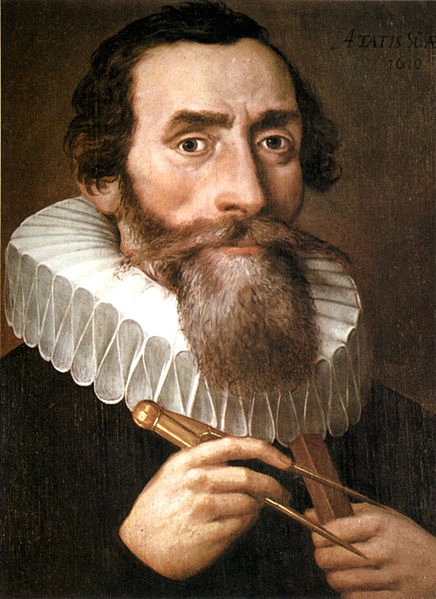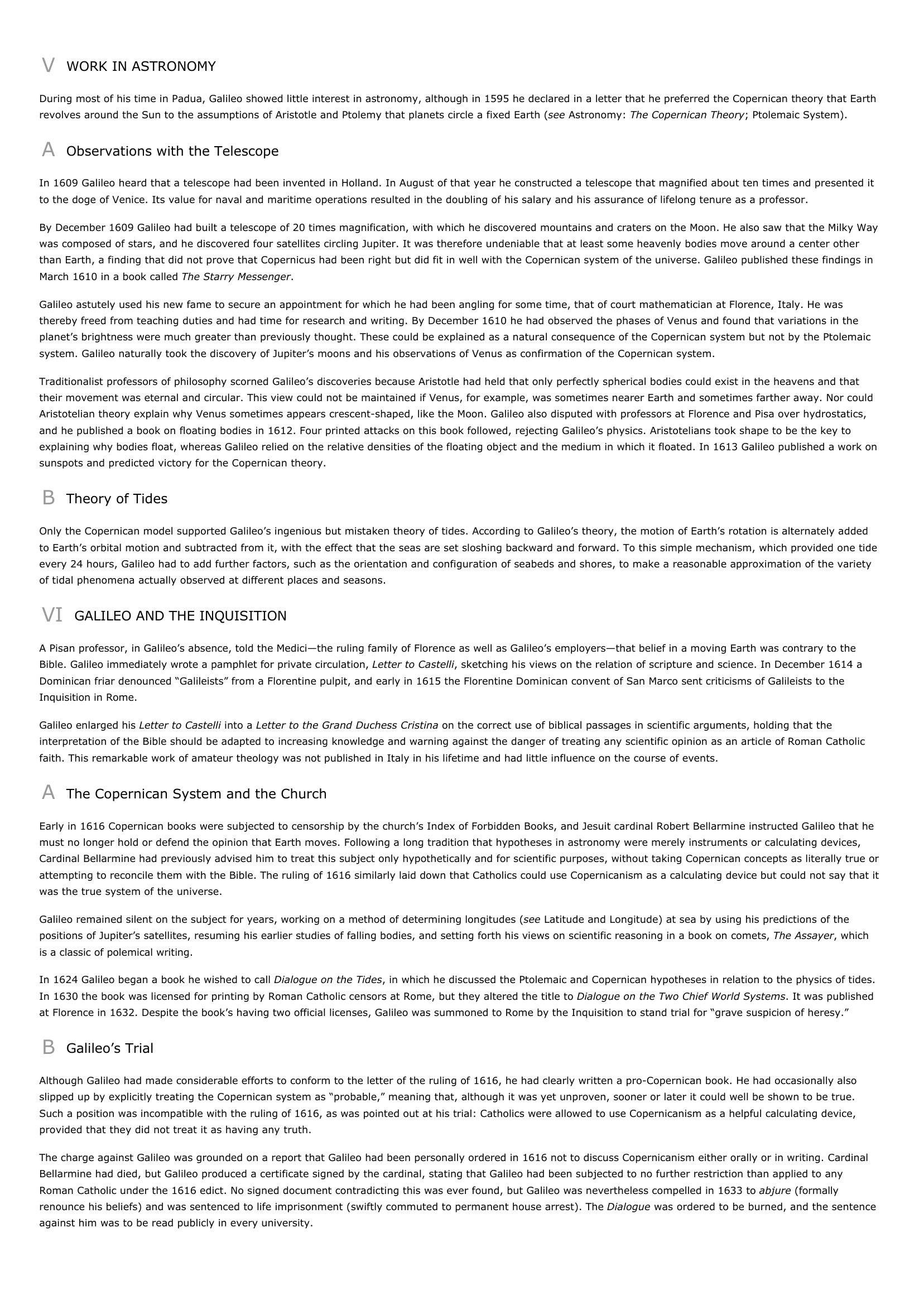Galileo I INTRODUCTION Galileo (1564-1642), Italian physicist and astronomer who, with German astronomer Johannes Kepler, initiated the scientific revolution that flowered in the work of English physicist Sir Isaac Newton.
Publié le 10/05/2013

Extrait du document


«
V WORK IN ASTRONOMY
During most of his time in Padua, Galileo showed little interest in astronomy, although in 1595 he declared in a letter that he preferred the Copernican theory that Earthrevolves around the Sun to the assumptions of Aristotle and Ptolemy that planets circle a fixed Earth ( see Astronomy: The Copernican Theory ; Ptolemaic System).
A Observations with the Telescope
In 1609 Galileo heard that a telescope had been invented in Holland.
In August of that year he constructed a telescope that magnified about ten times and presented itto the doge of Venice.
Its value for naval and maritime operations resulted in the doubling of his salary and his assurance of lifelong tenure as a professor.
By December 1609 Galileo had built a telescope of 20 times magnification, with which he discovered mountains and craters on the Moon.
He also saw that the Milky Waywas composed of stars, and he discovered four satellites circling Jupiter.
It was therefore undeniable that at least some heavenly bodies move around a center otherthan Earth, a finding that did not prove that Copernicus had been right but did fit in well with the Copernican system of the universe.
Galileo published these findings inMarch 1610 in a book called The Starry Messenger .
Galileo astutely used his new fame to secure an appointment for which he had been angling for some time, that of court mathematician at Florence, Italy.
He wasthereby freed from teaching duties and had time for research and writing.
By December 1610 he had observed the phases of Venus and found that variations in theplanet’s brightness were much greater than previously thought.
These could be explained as a natural consequence of the Copernican system but not by the Ptolemaicsystem.
Galileo naturally took the discovery of Jupiter’s moons and his observations of Venus as confirmation of the Copernican system.
Traditionalist professors of philosophy scorned Galileo’s discoveries because Aristotle had held that only perfectly spherical bodies could exist in the heavens and thattheir movement was eternal and circular.
This view could not be maintained if Venus, for example, was sometimes nearer Earth and sometimes farther away.
Nor couldAristotelian theory explain why Venus sometimes appears crescent-shaped, like the Moon.
Galileo also disputed with professors at Florence and Pisa over hydrostatics,and he published a book on floating bodies in 1612.
Four printed attacks on this book followed, rejecting Galileo’s physics.
Aristotelians took shape to be the key toexplaining why bodies float, whereas Galileo relied on the relative densities of the floating object and the medium in which it floated.
In 1613 Galileo published a work onsunspots and predicted victory for the Copernican theory.
B Theory of Tides
Only the Copernican model supported Galileo’s ingenious but mistaken theory of tides.
According to Galileo’s theory, the motion of Earth’s rotation is alternately addedto Earth’s orbital motion and subtracted from it, with the effect that the seas are set sloshing backward and forward.
To this simple mechanism, which provided one tideevery 24 hours, Galileo had to add further factors, such as the orientation and configuration of seabeds and shores, to make a reasonable approximation of the varietyof tidal phenomena actually observed at different places and seasons.
VI GALILEO AND THE INQUISITION
A Pisan professor, in Galileo’s absence, told the Medici—the ruling family of Florence as well as Galileo’s employers—that belief in a moving Earth was contrary to theBible.
Galileo immediately wrote a pamphlet for private circulation, Letter to Castelli , sketching his views on the relation of scripture and science.
In December 1614 a Dominican friar denounced “Galileists” from a Florentine pulpit, and early in 1615 the Florentine Dominican convent of San Marco sent criticisms of Galileists to theInquisition in Rome.
Galileo enlarged his Letter to Castelli into a Letter to the Grand Duchess Cristina on the correct use of biblical passages in scientific arguments, holding that the interpretation of the Bible should be adapted to increasing knowledge and warning against the danger of treating any scientific opinion as an article of Roman Catholicfaith.
This remarkable work of amateur theology was not published in Italy in his lifetime and had little influence on the course of events.
A The Copernican System and the Church
Early in 1616 Copernican books were subjected to censorship by the church’s Index of Forbidden Books, and Jesuit cardinal Robert Bellarmine instructed Galileo that hemust no longer hold or defend the opinion that Earth moves.
Following a long tradition that hypotheses in astronomy were merely instruments or calculating devices,Cardinal Bellarmine had previously advised him to treat this subject only hypothetically and for scientific purposes, without taking Copernican concepts as literally true orattempting to reconcile them with the Bible.
The ruling of 1616 similarly laid down that Catholics could use Copernicanism as a calculating device but could not say that itwas the true system of the universe.
Galileo remained silent on the subject for years, working on a method of determining longitudes ( see Latitude and Longitude) at sea by using his predictions of the positions of Jupiter’s satellites, resuming his earlier studies of falling bodies, and setting forth his views on scientific reasoning in a book on comets, The Assayer , which is a classic of polemical writing.
In 1624 Galileo began a book he wished to call Dialogue on the Tides , in which he discussed the Ptolemaic and Copernican hypotheses in relation to the physics of tides. In 1630 the book was licensed for printing by Roman Catholic censors at Rome, but they altered the title to Dialogue on the Two Chief World Systems .
It was published at Florence in 1632.
Despite the book’s having two official licenses, Galileo was summoned to Rome by the Inquisition to stand trial for “grave suspicion of heresy.”
B Galileo’s Trial
Although Galileo had made considerable efforts to conform to the letter of the ruling of 1616, he had clearly written a pro-Copernican book.
He had occasionally alsoslipped up by explicitly treating the Copernican system as “probable,” meaning that, although it was yet unproven, sooner or later it could well be shown to be true.Such a position was incompatible with the ruling of 1616, as was pointed out at his trial: Catholics were allowed to use Copernicanism as a helpful calculating device,provided that they did not treat it as having any truth.
The charge against Galileo was grounded on a report that Galileo had been personally ordered in 1616 not to discuss Copernicanism either orally or in writing.
CardinalBellarmine had died, but Galileo produced a certificate signed by the cardinal, stating that Galileo had been subjected to no further restriction than applied to anyRoman Catholic under the 1616 edict.
No signed document contradicting this was ever found, but Galileo was nevertheless compelled in 1633 to abjure (formally renounce his beliefs) and was sentenced to life imprisonment (swiftly commuted to permanent house arrest).
The Dialogue was ordered to be burned, and the sentence against him was to be read publicly in every university..
»
↓↓↓ APERÇU DU DOCUMENT ↓↓↓
Liens utiles
- Isaac NewtonIINTRODUCTIONIsaac Newton (1642-1727), English physicist, mathematician, and natural philosopher, considered one of the most important scientists of all time.
- William Shakespeare I INTRODUCTION William Shakespeare English playwright and poet William Shakespeare, who lived in the late 1500s and early 1600s, is regarded as the greatest dramatist in the history of English literature.
- William Blake I INTRODUCTION William Blake (1757-1827), English poet, painter, and engraver, who created an unusual form of illustrated verse; his poetry, inspired by mystical vision, is among the most original, lyric, and prophetic in the language.
- Dante Alighieri I INTRODUCTION Dante Alighieri (1265-1321), Italian poet, and one of the supreme figures of world literature, who was admired for the depth of his spiritual vision and for the range of his intellectual accomplishment.
- Walter Gropius Walter Gropius (1883-1969), German American architect and educator, who founded the Bauhaus, a German art school that became a seminal force in architecture and applied art during the first half of the 20th century.




